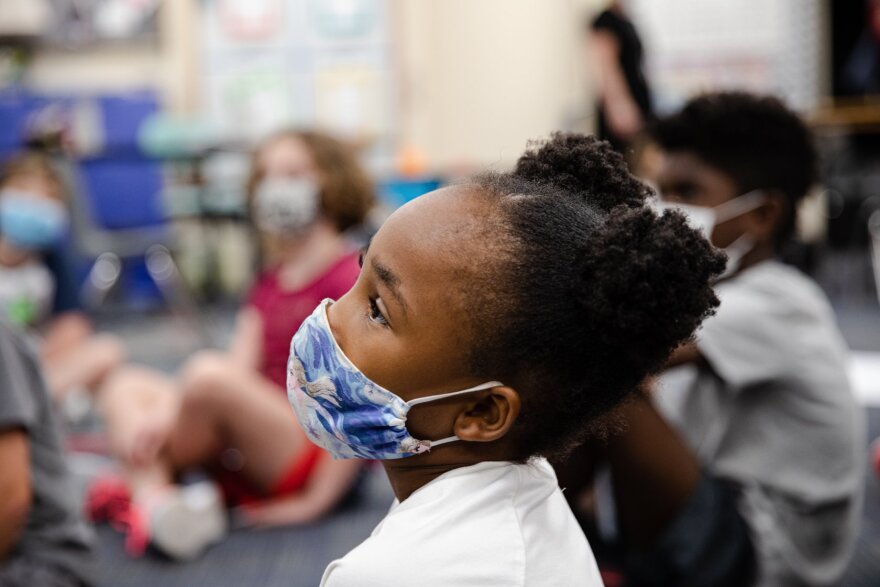The youngest students in several Kansas City area districts – including Blue Valley, Lee’s Summit and Olathe – are headed back to school next month, but older students must stay home.
That’s because pediatric infectious disease experts generally agree that kids younger than 10 spread the coronavirus less effectively than older children and adults.
“The more in-person we are, the better we’re going to be able to serve kids,” Lee’s Summit Superintendent David Buck told the school board on Tuesday. “There’s no doubt about that. Everyone says that – the American Academy of Pediatrics, the Centers for Disease Control and Prevention. And in my household, I have a third grader, a sixth-grader and a sophomore.”
The Jackson County Health Department has recommended a virtual start to the school year for all students, even those in early elementary school.
Buck said that’s where guidance isn’t matching up with research.
“Early research showed that children under the age of 10 do not transmit at nearly the rate that older kids do,” Buck said. “That may change, but currently we have no data or research showing they do transmit it at a high rate.”
Tina Tan is a pediatric infectious disease expert who teaches at Northwestern University and practices at Lurie Children’s Hospital of Chicago. She helped NPR develop a guide for parents trying to determine how safe their school’s re-entry plan is.
“It appears that yes, it is safer to have younger children go back to school,” Tan told NPR. “However, the school needs to have mitigation protocols in place.”
By now, everyone has heard that it’s important to wear a mask, wash your hands and maintain adequate social distance. In classrooms, where it might not be possible to get six feet of space between desks, students should be at least three feet apart.
Buck said that most in-person classes will have fewer than 18 students, though there was one school with classes of 21. In Independence, where students have already gone back to school, class sizes are also smaller than they usually would be. Superintendent Dale Herl told KCUR he had one class with just five students in it.
Smaller classes make social distancing easier. But Tan said the best preventative measure might be cohorting – keeping the same kids together all day, every day.
“The most effective way of doing in-person learning is to have small cohorts of students and teachers, to basically have the kids do everything in one classroom,” Tan said. “Have teachers rotate.”
She said that applies to elective classes like art and music as well as student support services.
“Let’s say a special needs student has a particular therapy they’re undergoing,” Tan said. “Have that teacher actually come to the classroom and work with that student, as opposed to having the student move around the hallways. You want to minimize the amount of potential contacts individuals can have with other individuals.”
The need to maintain consistent cohorts is what makes reopening middle and high schools so fraught. Students switch classes multiple times a day, and it’s impossible to thoroughly clean a classroom in five minutes.
Tan says hybrid models – where students go every other day – might work to reduce the risk for students and teachers, but the school would require deep cleaning every evening. Schools in Missouri can’t have students in-person every other week because of how the state is tracking attendance.
In Johnson County, where the health department has said schools can bring younger students back for in-person learning, the Shawnee Mission School District has said everyone will start the school year virtually.
“I will be honest,” board president Heather Ousley wrote on Facebook. “I did not know this job would entail keeping folks alive. Whether those folks were students, or staff, or the third generation living with our families. Or our minority families who are hit harder.”
Ousley went on to say that Shawnee Mission will learn from its neighbors who are going in-person before bringing back the youngest students, who pediatricians say need to be back in school.
Part of the challenge for school administrators right now is that the science of COVID-19 isn’t settled. The latest from the CDC is that young children likely have the same or higher viral load as adults and have spread the virus effectively in households and at summer camps.
Since kids tend to get less sick from the coronavirus than adults, that means the greatest risk is to parents, teachers and coaches.
But it’s not true that kids are “almost immune” from the coronavirus, as President Trump has stated. And Black and Latino children are eight times as likely as their white peers to be hospitalized with COVID-19 symptoms.






